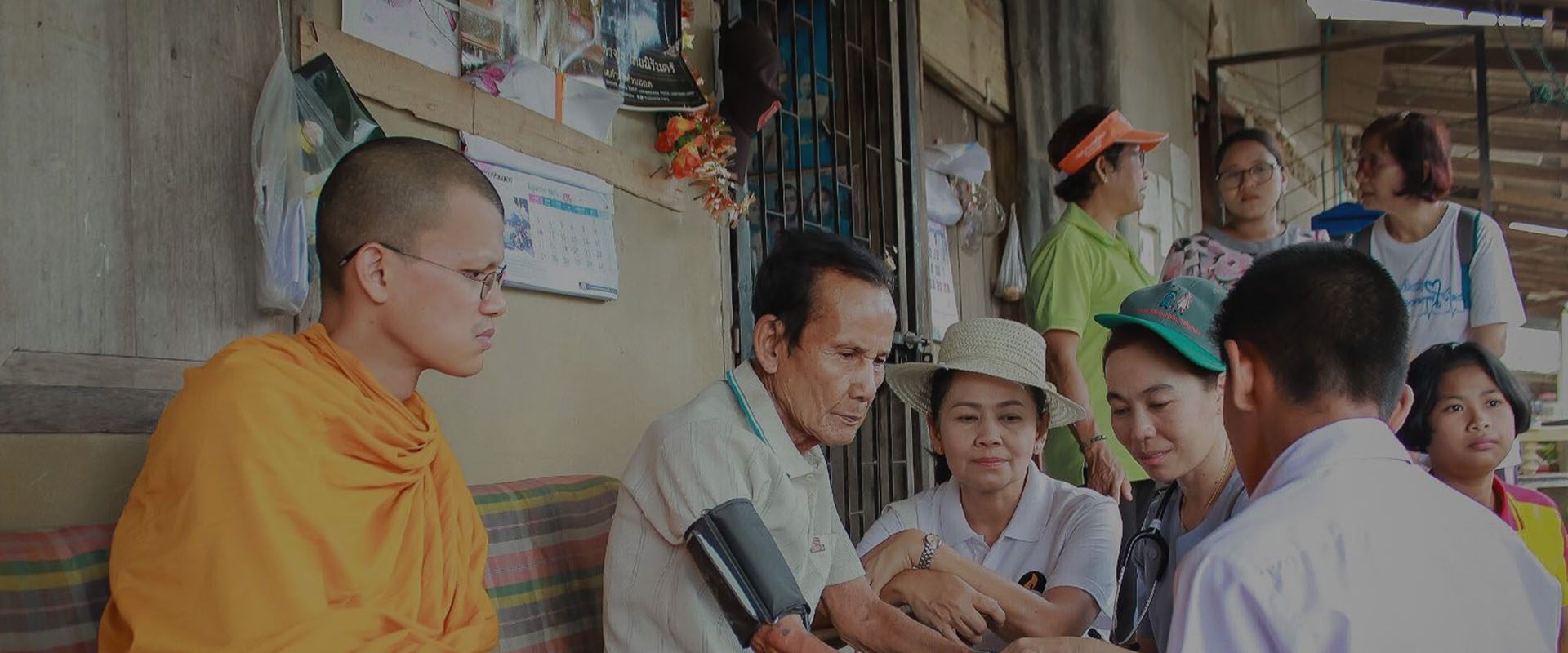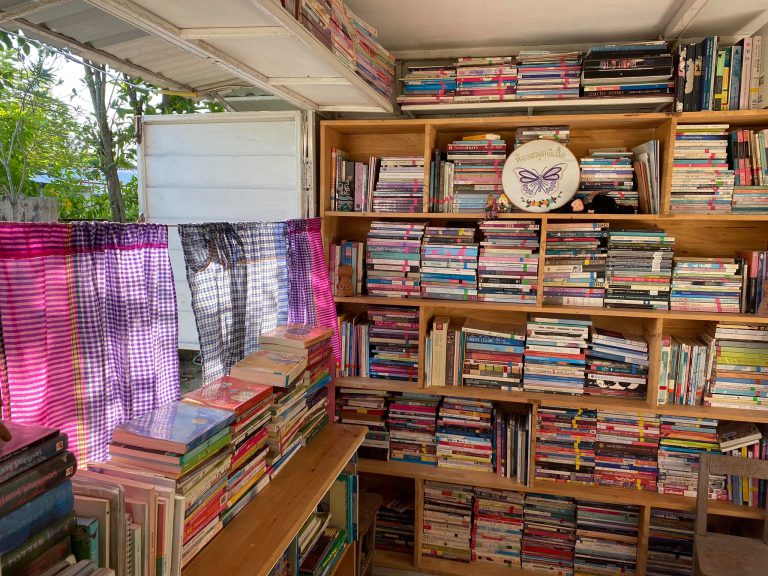Story: Woraphong Wechamaleenonda
The Beginning
Huai Yod is an old, historic prefecture in Trang province, with a market located on Phetkasem road, which stretches down to meet the Southern border. During the reign of King Rama 5, the area was the seat of the tin mining industry, which came to an end around 40 years ago. Most of the population are Thai-Chinese, whose ancestors migrated to work in the tin mines and ended up living in the area to this day. The Thesaban district alone has eight chinese shrines, a mosque, a church and a single temple: Wat Huai Yod, founded over a hundred years ago, and the birthplace of the Yellow Robe Collective for Friends at the End of Life.
Phra Krodsada Khantigaro, the founder of the Yellow Robe Collective, was born and raised in Huai Yod. When he finished his sophomore year of high school, he left Huai Yod in search of the world beyond his hometown, and took up a job at a hotel in Pattaya for 12 years. He had always been interested in buddhist philosophy and would often visit the temple with a circle of buddhist scholars, and meditate with Venerable Father Charan Thathammo at Wat Amphawan in Sing Buri province. When he turned thirty, he decided to return home to Huai Yod and ordain as a monk.
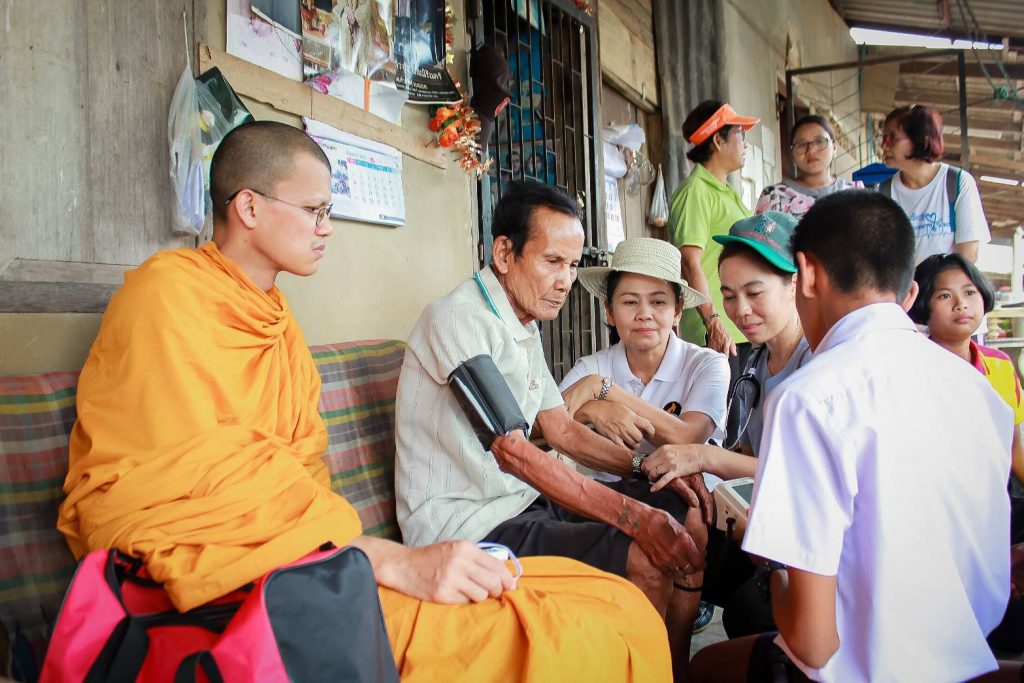
When he was first ordained, Phra Krodsada devoted himself to the study of bhuddist scriptures. Once he understood the contours of a monk’s self-conduct and daily practice, he moved to the city and began his studies in advanced dharma scholarship and sanskrit in his third year. During this time, he came across Phra Phaisan Visalo’s foundation for bedside care and peaceful death through social media, and saw a news clip of volunteer monks from the Gilanadhamma organisation visiting patients in hospitals. They became a spark of inspiration, and he began volunteering with patients alongside his studies.
Then, an opportunity presented itself when the college closed during the buddhist holy days and he returned to Wat Huai Yod to continue his practice. Nurses from the Huai Yod hospital came to the temple to give the monks a health check-up. Phra Krodsada asked the nurses whether the hospital offered palliative care services and they told him to contact Darunee Chanachai, a nurse in Huai Yod hospital’s palliative care unit, and gave him her number. He spoke to her and asked to meet her in person at the hospital the next day to explain why he wanted to begin visiting their patients, and how monks could be of service to the hospital.
After a week, the hospital contacted him with an invitation to join a team on a home visit but because the visit conflicted with his classes, he was unable to go. Not long after that, Ms. Darunee reached out to him once more. This time, Phra Krodsada decided to take time off school and get on a bus from Trang to Huai Yod hospital, in order to join the hospital team on their patient visits.

Ms. Darunee shares that “There aren’t many monks in Trang who are interested in palliative care. Then one day, [Phra Krodsada] came to us, saying that he wanted to work with us. So we met, to see whether we shared a similar approach to patient care. When we saw that we did, I called him and invited him on a visit to one of our patients, who is poor. He has cancer, but no one to look after him. He had wounds on his body that were filled with worms. I kept an eye on [Phra Krodsada] to see whether he would be able to care for the patients on our visits. He was able to support and connect with all of them, so I continued to ask him to accompany us on our visits. But he hasn’t been able to visit all of our patients, because people in the South believe that to have a monk visit a sick person is inauspicious. [Phra Krodsada] can’t approach them on his own, but must go through a system overseen by the hospital.”
“I didn’t know what to say on my first visit”, says Phra Krodsada, “because I had no experience. Being with end-stage patients isn’t the same as visiting the average patient. Usually, I’ll let the medical team take charge and provide support only when it is asked for.”
The Arokayasala Centre
The Huai Yod Hospital has offered palliative care services for ten years, long before the Ministry of Public Health introduced palliative care legislation at the national level. However, their palliative care service was volunteer-led, without a designated department and staff. At the time, palliative care volunteers looked after end-stage patients in the general hospital building, until a new policy was introduced for the creation of an experimental pastoral care and rehabilitation centre for chronically-ill patients with a multidisciplinary staff. Composed of doctors, nurses, physical therapists, practitioners of alternative and Thai homeopathic medicine, nutritionists and community helpers, the department would also be connected to local doctors and surrounding communities so that patients and their families can take care of themselves effectively.
The Arokayasala Centre at Huai Yod hospital in the south of Thailand is one of five pastoral care centres in the country. The centre officially opened in 2016 and has an 8-bed capacity. In addition to treating chronically-ill patients, the centre also provides palliative care for end-stage patients. It has also been the main base of operations for the Yellow Robe Collective from its founding to the present.
Though Phra Krodsada was quite inexperienced to begin with, his first series of patient visits inspired him to take up patient care seriously and led him to found the Yellow Robe Collective. “The day after I visited an older woman, I decided to bring her a pill organiser since I saw that there wasn’t one in the house. But before I arrived, I received a call from the hospital telling me that she had passed away after being bedridden for almost ten years.” The incident taught him much; in particular, not to carelessly fritter life away, for death waits for no one. One of her caregivers remarked to Phra Krodsada that “[the old woman] had been bedridden for many years and had never been visited by a monk. Yesterday, she was able to give offerings and make merit. She got to hold the hem of a monk’s yellow robes in her hands. She has left us in peace.” That was when he had the stroke of inspiration that later led to the founding of The Wat Huai Yod Yellow Robe Collective For Friends At the End of Life.
After many other patient visits, Phra Krodsada decided to drop his study of Sanskrit to devote himself to end-of-life care and build a volunteer network committed to patient care. He also had the idea of establishing support infrastructure for caregiving work. Relying on his personal connections, he began by looking for transportation volunteers, persuading his friends at the temple to drive him to meet patients. He also brought in his family members to help run the collective. They became the original group of volunteers, and were essential to the smooth operation of the Yellow Robe Collective. The group slowly grew into a strong volunteer department, with ten teachers and caregivers (people who look after seniors who are dependent on help) whose combined efforts have expanded the collective into what it is today.
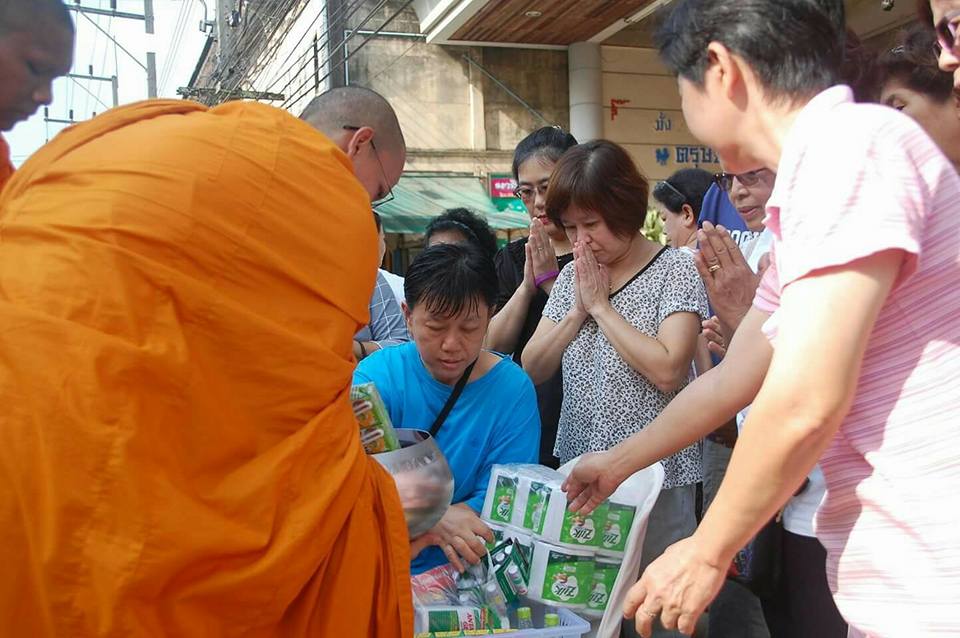
The Yellow Shoulder Bag Organisation
For the first six months, the collective’s patient visits were funded by offerings and the money that Phra Krodsada had saved before he became a monk, which were used to buy gifts for patients and pay for gas. They didn’t take donations at the time, out of the concern that outsiders might assume that Phra Krodsada was taking advantage of the patients. However, the Yellow Robe Collective’s first official donation-based project, “The Yellow Shoulder Bag Organisation”, was not even connected to patient visits, but arose from relief efforts for the Border Patrol Police School when it was destroyed by a mudslide during the flood in Nakhon Si Thammarat province at the end of 2016. Responding to requests from acquaintances, the Yellow Robe collective produced cloth bags, filled them with dry foods from collected alms, and donated them to the police school. Afterwards, the activity became a constant part of their patient visits. To this day, the Chiwit Sikha (Virtuous Life) organisation sends cloth bags to be given to patients as gifts of encouragement, in support of the Yellow Robe Collective’s work.
Working with the Yellow Robe Collective led Phra Krodsada to a profound appreciation of the importance of giving, which creates a connection between giver and receiver, as a tool for building volunteer networks. As more people began to come across the collective and express interest in becoming involved, the collective began accepting donations of supplies for their patients. At first, the donations consisted of basic necessities from the monks’ alms, such as toothpaste, toothbrushes, soap and powder, before they began incorporating the food Phra Krodsada received from alms-givers. The initiative was then expanded into the “From the Bottom of Alms Bowls to Patients’ Hearts” organisation, which takes food donations from monks’ alms and distributes them to hospitalized patients and their families. In addition to getting more than ten more monks involved and acquainted with the collective’s work, the organisation also raised awareness of the collective among alms-givers in the community, with some of them even offering to volunteer after a while.
As per the Arokayasala Centre’s exhortation, visiting patients does not only involve bringing them supplies. Phra Krodsada places an emphasis on listening to patients and discussion of buddhist scripture, in order to give comfort and encouragement to patients and their caregivers. He also gives counsel to patients’ families, so that they are able to encounter death peacefully when their loved one arrives at the end of their life.
On top of bedside visits to end-stage patients, the Arokyasala centre also offers other modes of spiritual healing for patients and their families, such as hosting the “Dharma Healing Clinic” on every second and fourth Thursday of the month. During these clinics, Phra Krodsada leads a guided meditation and discussion of buddhist scripture for staff, patients and their families. The centre also uses buddhist ordination, such as the sanghathan, to bring patients and families together in a shared activity. Akin to a “family meeting”, the ceremony also provides the opportunity for families to make merit together and lifts everyone’s spirits.
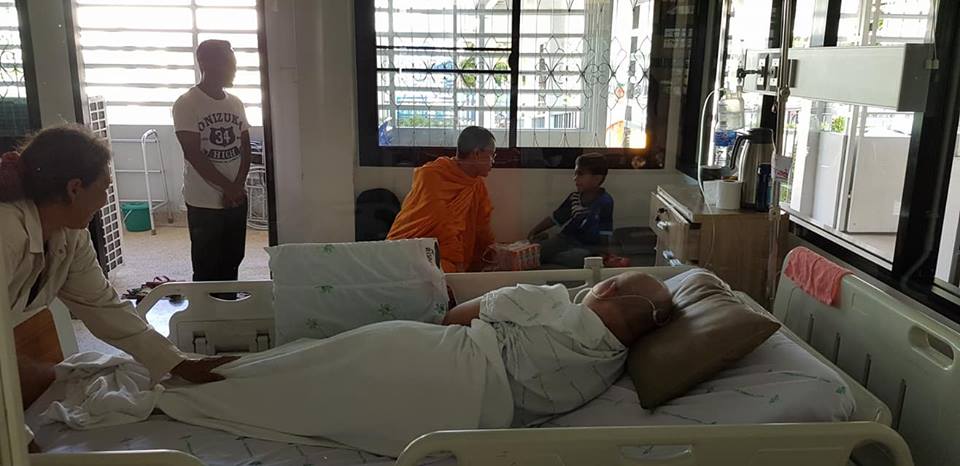
The first part of the Yellow Robe Collective’s volunteer training is work experience in a hospital setting. There, trainees accrue knowledge and experience in providing spiritual care for end-stage patients and their families. The experience broadened Phra Krodsada’s understanding of sickness in many ways and affirmed to him that monks can play a more expansive role than simply visiting patients in hospitals by taking their work to sick people in the community as well.
Interviews conducted:
- Phra Krodsada Khantigaro, president of the Huai Yod Yellow Robe Collective in Service of End-stage Patients
- Darunee Chanachai, a professionally-trained palliative care nurse at the Arokayasala centre, Huai Yod hospital
- Barmita Liao Phatthanaphong, a village health volunteer, caregiver and assistant of the Yellow Robe Collective
Photographs:
- FB: Phra Krodsada Khantigaro, the sangha of spiritual healing
- The Yellow Robe Collective in Service of End-stage Patients
- Arokayasala centre, Huai Yod hospital
